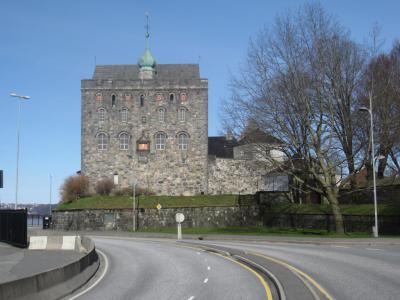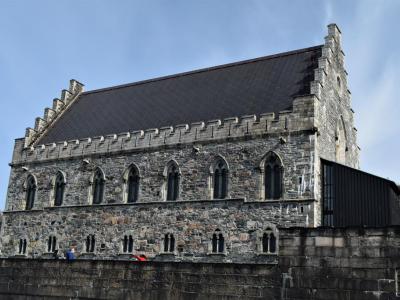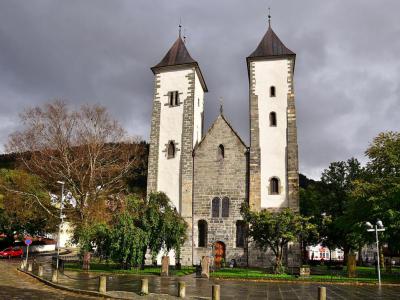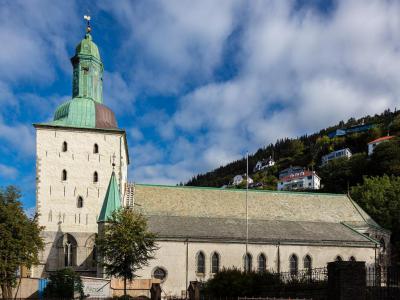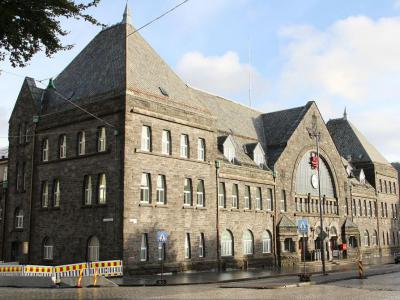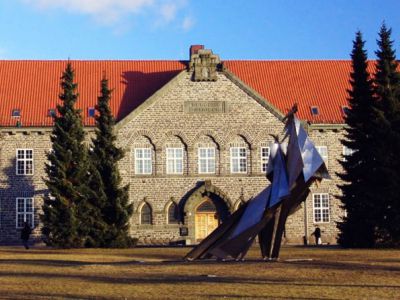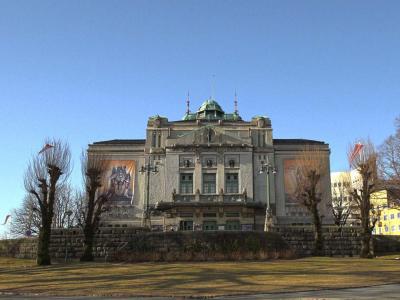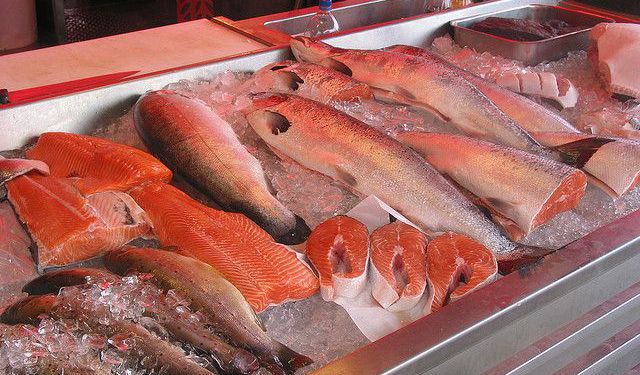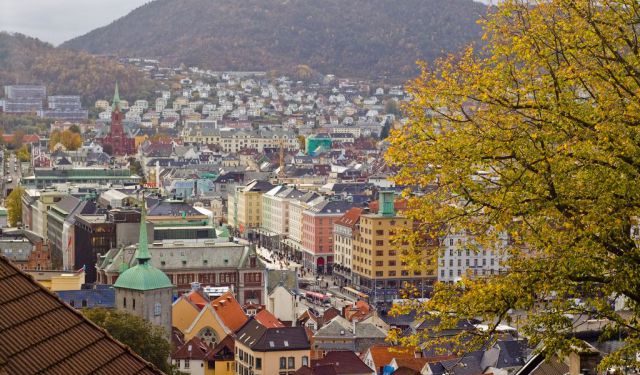Bergen's Architectural Jewels (Self Guided), Bergen
Surprising as it may appear, but the seemingly small city of Bergen for centuries had been the largest in all of the Nordic countries. It also remained so for Norway until the 1830s. Apart from being the country's former capital (back in the 13th century), Bergen is well-known primarily for its astoundingly beautiful cityscape, formed by the backdrop of mountains and serene waterfront, much as the architectural jewels scattered amid the rows of colorful higgledy-piggledy small wooden houses with triangular gables, cobbled streets and flowers everywhere.
Despite its somewhat dejected history of numerous fires, which over the years had burnt to ashes almost 90% of the city, today's Bergen is as picturesque as ever. Years of careful restoration have earned it the proud status of a UNESCO World Heritage site.
Other than its world-famous, photogenic quayside Bryggen area, there are many other notable sights in Bergen well worthy of being on every architecture buff’s itinerary. Here are just some of them:
Bergenhus Fortress – former seat of the Norwegian royals; built on the ruins of an older bastion, Sverreborg, dated from the 1200s.
Haakon's Hall – a medieval Gothic structure, part of the Bergenhus complex; formerly a ceremonial hall.
St. Mary's Church – the Romanesque cathedral, oldest remaining building in Bergen, dating back to the 1130s.
Bergen Railway Station – a perfect example of the National Romantic architecture; erected in 1913.
Den Nationale Scene – Bergen's largest theatre; housed in the Art Nouveau edifice of 1909.
If you wish to explore these and other architecturally unique buildings in Bergen more closely, take this self-guided walking tour.
Despite its somewhat dejected history of numerous fires, which over the years had burnt to ashes almost 90% of the city, today's Bergen is as picturesque as ever. Years of careful restoration have earned it the proud status of a UNESCO World Heritage site.
Other than its world-famous, photogenic quayside Bryggen area, there are many other notable sights in Bergen well worthy of being on every architecture buff’s itinerary. Here are just some of them:
Bergenhus Fortress – former seat of the Norwegian royals; built on the ruins of an older bastion, Sverreborg, dated from the 1200s.
Haakon's Hall – a medieval Gothic structure, part of the Bergenhus complex; formerly a ceremonial hall.
St. Mary's Church – the Romanesque cathedral, oldest remaining building in Bergen, dating back to the 1130s.
Bergen Railway Station – a perfect example of the National Romantic architecture; erected in 1913.
Den Nationale Scene – Bergen's largest theatre; housed in the Art Nouveau edifice of 1909.
If you wish to explore these and other architecturally unique buildings in Bergen more closely, take this self-guided walking tour.
How it works: Download the app "GPSmyCity: Walks in 1K+ Cities" from Apple App Store or Google Play Store to your mobile phone or tablet. The app turns your mobile device into a personal tour guide and its built-in GPS navigation functions guide you from one tour stop to next. The app works offline, so no data plan is needed when traveling abroad.
Bergen's Architectural Jewels Map
Guide Name: Bergen's Architectural Jewels
Guide Location: Norway » Bergen (See other walking tours in Bergen)
Guide Type: Self-guided Walking Tour (Sightseeing)
# of Attractions: 7
Tour Duration: 2 Hour(s)
Travel Distance: 2.9 Km or 1.8 Miles
Author: DanaOffice
Sight(s) Featured in This Guide:
Guide Location: Norway » Bergen (See other walking tours in Bergen)
Guide Type: Self-guided Walking Tour (Sightseeing)
# of Attractions: 7
Tour Duration: 2 Hour(s)
Travel Distance: 2.9 Km or 1.8 Miles
Author: DanaOffice
Sight(s) Featured in This Guide:
- Bergenhus Fortress and Rosenkrantz Tower
- Haakon's Hall
- St. Mary's Church
- Bergen Cathedral
- Bergen Railway Station
- Bergen Public Library
- Den Nationale Scene (The National Scene)
1) Bergenhus Fortress and Rosenkrantz Tower (must see)
The tower and the Fortress must be thought of as one establishment. The Fortress has been a royal seat and residence, episcopal see and a military power base. The grounds within the walls of the island fortress are Holmen, Koengen and Sverresborg. The Fortress was built in the early 1500s. It was considered complete in 1700.
The Fortress was under siege only once during the second Dutch-English War. In August, 1665, a squadron of Dutch vessels took shelter in neutral Bergen Harbor. The neutrality was not respected. The English warships fired on the Dutch ships and the Fortress. Fire was returned. The battle was a short one. It came to be known as The Battle of Vagen.
The English were attacking vessels of the Dutch East India Company. The attack failed. No ships were sunk. In the Second World War Bergenhus was once again in service. This time however it was a German occupying force that used the fort as their western headquarters.
Begenhus has been a military facility without interruption since 1628. Presently 220 military and civilian personnel are stationed at the fort.
The Rosenkrantz Tower is the dominant building of the fort complex. It was named for governor Erik Rosenkrantz. The tower got its present form during Rosenkrantz's reign, 1559-1568. There is a yet older part of the tower. It is a medieval tower called the "keep by the Sea." It was built by King Magnus the Lawmaker in 1270.
Rosenkrantz's building held dungeons on the first floor and cannons on the roof. With residential rooms in between it must have been insufferably loud in a battle. Not a good place for meditation.
The other medieval structure to remain is Haakon's Hall, built about 1270. It was incorporated in Rosenkrantz's Tower. Several Churches, including Bergen's Christ Church were included in the premises. The churches were demolished by 1531 and the isle of Holmen became strictly military.
The Fortress was under siege only once during the second Dutch-English War. In August, 1665, a squadron of Dutch vessels took shelter in neutral Bergen Harbor. The neutrality was not respected. The English warships fired on the Dutch ships and the Fortress. Fire was returned. The battle was a short one. It came to be known as The Battle of Vagen.
The English were attacking vessels of the Dutch East India Company. The attack failed. No ships were sunk. In the Second World War Bergenhus was once again in service. This time however it was a German occupying force that used the fort as their western headquarters.
Begenhus has been a military facility without interruption since 1628. Presently 220 military and civilian personnel are stationed at the fort.
The Rosenkrantz Tower is the dominant building of the fort complex. It was named for governor Erik Rosenkrantz. The tower got its present form during Rosenkrantz's reign, 1559-1568. There is a yet older part of the tower. It is a medieval tower called the "keep by the Sea." It was built by King Magnus the Lawmaker in 1270.
Rosenkrantz's building held dungeons on the first floor and cannons on the roof. With residential rooms in between it must have been insufferably loud in a battle. Not a good place for meditation.
The other medieval structure to remain is Haakon's Hall, built about 1270. It was incorporated in Rosenkrantz's Tower. Several Churches, including Bergen's Christ Church were included in the premises. The churches were demolished by 1531 and the isle of Holmen became strictly military.
2) Haakon's Hall
Haakon's Hall, located within the Bergenhus Fortress in Bergen, is a medieval stone hall built in the mid-13th century during the reign of King Håkon Håkonsson (1217-1263). As the largest secular medieval building in Norway, it stands as a significant monument of Gothic architecture. Constructed to replace earlier wooden structures, the hall showcases the influence of English design, likely due to the friendly relations between King Håkon and King Henry III of England, and possibly designed by English architects.
The hall, built between 1247 and 1261, served as a royal residence and feasting hall. It played a central role in major national events, such as the marriage of King Håkon's son, Magnus Håkonsson Lagabøte, to the Danish princess Ingeborg in 1261, an event which hosted 2000 guests across three buildings. During medieval times, Bergen was the largest and most important city in Norway, and Haakon's Hall was the venue for significant state affairs, including the proclamation of Norway's first complete set of laws.
Haakon's Hall comprises three floors: a large festive room on the top floor, a middle floor originally used for administration and the King's council, and a cellar likely used for storage. Despite its initial prominence, the hall's role diminished after the royal family left Norway in the late Middle Ages. It then served various utilitarian purposes, including as a storeroom and an ammunition depot, and even lost its roof at one point.
In 1916, Haakon's Hall underwent its first restoration and interior decoration. However, in 1944, it was heavily damaged by an explosion from the Dutch ammunition ship Voorbode in Bergen harbor. The hall was left with only its walls standing and underwent significant restoration in the 1950s to achieve its current form.
Today, Haakon's Hall is a cultural heritage site and museum. It continues to be used for royal dinners, official occasions, and concerts, preserving its historical significance and continuing its legacy as a centerpiece of Norwegian medieval architecture and history.
The hall, built between 1247 and 1261, served as a royal residence and feasting hall. It played a central role in major national events, such as the marriage of King Håkon's son, Magnus Håkonsson Lagabøte, to the Danish princess Ingeborg in 1261, an event which hosted 2000 guests across three buildings. During medieval times, Bergen was the largest and most important city in Norway, and Haakon's Hall was the venue for significant state affairs, including the proclamation of Norway's first complete set of laws.
Haakon's Hall comprises three floors: a large festive room on the top floor, a middle floor originally used for administration and the King's council, and a cellar likely used for storage. Despite its initial prominence, the hall's role diminished after the royal family left Norway in the late Middle Ages. It then served various utilitarian purposes, including as a storeroom and an ammunition depot, and even lost its roof at one point.
In 1916, Haakon's Hall underwent its first restoration and interior decoration. However, in 1944, it was heavily damaged by an explosion from the Dutch ammunition ship Voorbode in Bergen harbor. The hall was left with only its walls standing and underwent significant restoration in the 1950s to achieve its current form.
Today, Haakon's Hall is a cultural heritage site and museum. It continues to be used for royal dinners, official occasions, and concerts, preserving its historical significance and continuing its legacy as a centerpiece of Norwegian medieval architecture and history.
3) St. Mary's Church
Saint Mary's church is a "long" style church of grey stone built around 1135. The architect is unknown but he would have been pleased to know his structure has withstood time and fortune so well. The church is used today and it seats about 240 people. It is definitely the oldest building in the City of Bergen.
Saint Mary's is only survivor of the 12 churches and three monasteries that were built during the ring of Olav Kyrre (1066-1093). The church was probably built by craftsmen from Scania, in Denmark. The sryle of the church resembles that of Lund Cathedral in Scania.
The church was intended for the Norwegian people of Bergen, but it was taken over by the German population the town in 1408. It was locally named the "German" church and it served mainly the rich Hanseatic merchants. While it belonged to the Germans, Saint Mary's prospered and did not fall into ruin like several other churches of Bergen.
In January 2010 major restoration work was undertaken. When finished the Church became associated with the Bergen Anglican denomination and began offering services in English.
The church has two towers and three naves and is mostly Romanesque in style. The choir is a bit Gothic like Haakon's Hall. The main building material is three grades of soapstone and some shale. The soapstone was likely quarried locally.
Saint Mary's is only survivor of the 12 churches and three monasteries that were built during the ring of Olav Kyrre (1066-1093). The church was probably built by craftsmen from Scania, in Denmark. The sryle of the church resembles that of Lund Cathedral in Scania.
The church was intended for the Norwegian people of Bergen, but it was taken over by the German population the town in 1408. It was locally named the "German" church and it served mainly the rich Hanseatic merchants. While it belonged to the Germans, Saint Mary's prospered and did not fall into ruin like several other churches of Bergen.
In January 2010 major restoration work was undertaken. When finished the Church became associated with the Bergen Anglican denomination and began offering services in English.
The church has two towers and three naves and is mostly Romanesque in style. The choir is a bit Gothic like Haakon's Hall. The main building material is three grades of soapstone and some shale. The soapstone was likely quarried locally.
4) Bergen Cathedral
Since 12th century, Bergen Cathedral has been through the fire. Through the fire several times in fact, more than most, in a city famous for devastating fires. And to top it all off it has been hit by a cannon ball, which sticks in the wall to this day. Fires and wars, but there is peace and beauty inside.
Bergen Cathedral is episcopal seat of home parish of the Church of Norway. Word of the church appears for the first time in 1181. To this day it remains dedicated to Saint Olaf.
In 1181, Jon Kutiza, a peasant rebel and his men chased a number of King Sverre's men into the cathedral (then known as Olavskirken). Under the reign of King Haakon IV, Franciscans built a friary connecting to the church. The church had a long design in a Romanesque style. It burned down in 1248.
A new stone church was erected and that caught fire in 1270. The church wasn't fully reconstructed until 1537, when it was designated the new cathedral of the Protestant persuasion. In 1702 there was another fire and another reconstruction. By the 1880s the Cathedral's interior was restored to its original Rococo appearance.
In the second English-Dutch war, in the sea battle of Vagen in 1665, the cathedral sustained a hit from a cannon shot gone wild. The ball sits today, ensconced in the front wall.
The cathedral today is used mainly for musical events.
Bergen Cathedral is episcopal seat of home parish of the Church of Norway. Word of the church appears for the first time in 1181. To this day it remains dedicated to Saint Olaf.
In 1181, Jon Kutiza, a peasant rebel and his men chased a number of King Sverre's men into the cathedral (then known as Olavskirken). Under the reign of King Haakon IV, Franciscans built a friary connecting to the church. The church had a long design in a Romanesque style. It burned down in 1248.
A new stone church was erected and that caught fire in 1270. The church wasn't fully reconstructed until 1537, when it was designated the new cathedral of the Protestant persuasion. In 1702 there was another fire and another reconstruction. By the 1880s the Cathedral's interior was restored to its original Rococo appearance.
In the second English-Dutch war, in the sea battle of Vagen in 1665, the cathedral sustained a hit from a cannon shot gone wild. The ball sits today, ensconced in the front wall.
The cathedral today is used mainly for musical events.
5) Bergen Railway Station
Bergen Railway Station, strategically positioned in the heart of Bergen, is a pivotal and historic transport hub that serves as the terminus for one of the world's most picturesque train journeys from Oslo. This station is not just a bustling gateway into the city but also an architectural marvel that entices both travelers and architecture enthusiasts alike.
Opened in 1913, four years after the completion of the Oslo-Bergen rail link, Bergen Railway Station replaced an older station to the west and marked a significant enhancement in the city's transport infrastructure. The station was designed by Jens Zetlitz Monrad Kielland, a prominent Norwegian architect renowned for his contributions to the National Romantic movement. This architectural style is a blend of the medieval influences and the modernist Jugendstil (Art Nouveau) that was prevalent in Northern Europe during that era. The station's design reflects these influences, combining robust, medieval-style heavy stonework with the more elegant and organic forms of Art Nouveau.
The station's main hall is particularly striking, where the solid stone structures are beautifully contrasted with an elegant roof and expansive glass windows. These features not only create a visually impressive space but also highlight the station’s most cherished view-the surrounding mountain landscape.
In its early years, Bergen Railway Station also became a notable HoReCa (Hotel, Restaurant, Café) destination. By the 1920s and 1930s, the area around the station had developed significantly; the Hotel Terminus was established in 1922, and a restaurant opened within the station in 1937, enhancing its role as a social and cultural meeting point.
Recognizing its historical and architectural value, the station building has been protected since 2003, ensuring that no significant alterations compromise its original design and heritage. This protection helps preserve the station not only as a functional transport hub but also as a historical monument that embodies the architectural and cultural spirit of early 20th-century Norway.
Opened in 1913, four years after the completion of the Oslo-Bergen rail link, Bergen Railway Station replaced an older station to the west and marked a significant enhancement in the city's transport infrastructure. The station was designed by Jens Zetlitz Monrad Kielland, a prominent Norwegian architect renowned for his contributions to the National Romantic movement. This architectural style is a blend of the medieval influences and the modernist Jugendstil (Art Nouveau) that was prevalent in Northern Europe during that era. The station's design reflects these influences, combining robust, medieval-style heavy stonework with the more elegant and organic forms of Art Nouveau.
The station's main hall is particularly striking, where the solid stone structures are beautifully contrasted with an elegant roof and expansive glass windows. These features not only create a visually impressive space but also highlight the station’s most cherished view-the surrounding mountain landscape.
In its early years, Bergen Railway Station also became a notable HoReCa (Hotel, Restaurant, Café) destination. By the 1920s and 1930s, the area around the station had developed significantly; the Hotel Terminus was established in 1922, and a restaurant opened within the station in 1937, enhancing its role as a social and cultural meeting point.
Recognizing its historical and architectural value, the station building has been protected since 2003, ensuring that no significant alterations compromise its original design and heritage. This protection helps preserve the station not only as a functional transport hub but also as a historical monument that embodies the architectural and cultural spirit of early 20th-century Norway.
6) Bergen Public Library
Bergen Public Library (BPL) in Bergen serves as a cornerstone of cultural and historical preservation and access in the region. Established in 1872, BPL is Norway’s second-largest public library, continuing a legacy of literacy that dates back to the Middle Ages. Historically, Bergen was a central hub of literacy with most books held in monasteries and churches. A notable early collection was housed in Saint Mary's Church.
The foundations for the library were laid in 1766 when the vicar of Saint Mary's Church donated part of the church's book collection and some funds towards establishing a public library. This institution would eventually evolve into the BPL. The church's entire collection was formally transferred to the library in 1876 and remained there until it was moved to the University Library of Bergen nearly a century later.
The library’s holdings were significantly enhanced in 1871 with the acquisition of another 12,000 volumes from Paul Botten-Hansen, the university librarian at that time. The initial site of the library, a former brewery, soon became inadequate due to the expanding collection, prompting a move to a former meat market.
The early 20th century underscored the need for a purpose-built facility to house the growing library. This need was met when Olaf Nordhagen won an architectural competition in 1906 to design a new building. His neo-Romanesque design was realized in 1917, providing a modern and spacious home for the library's extensive collections.
Today, the Bergen Public Library not only continues to function from this historical building, which is now a protected property, but it has also expanded its reach with six district branches throughout the city, serving as a vital educational and cultural resource for the community.
The foundations for the library were laid in 1766 when the vicar of Saint Mary's Church donated part of the church's book collection and some funds towards establishing a public library. This institution would eventually evolve into the BPL. The church's entire collection was formally transferred to the library in 1876 and remained there until it was moved to the University Library of Bergen nearly a century later.
The library’s holdings were significantly enhanced in 1871 with the acquisition of another 12,000 volumes from Paul Botten-Hansen, the university librarian at that time. The initial site of the library, a former brewery, soon became inadequate due to the expanding collection, prompting a move to a former meat market.
The early 20th century underscored the need for a purpose-built facility to house the growing library. This need was met when Olaf Nordhagen won an architectural competition in 1906 to design a new building. His neo-Romanesque design was realized in 1917, providing a modern and spacious home for the library's extensive collections.
Today, the Bergen Public Library not only continues to function from this historical building, which is now a protected property, but it has also expanded its reach with six district branches throughout the city, serving as a vital educational and cultural resource for the community.
7) Den Nationale Scene (The National Scene)
The National Scene (Den Nationale Scene), situated in Bergen, stands as the largest theatre in the city and one of the oldest permanent theatres in Norway. Established in 1850 through the efforts of Norwegian violinist Ole Bull, the theatre originally operated under the name the Norwegian Theatre. Its foundation aimed to support the evolution of Norwegian theatre and playwrights, featuring prominent figures such as Henrik Ibsen, who was one of its first writers-in-residence and art directors. Notably, Ibsen's pioneering contemporary realist drama, "The Pillars of Society," premiered nationally at this venue on November 30, 1877.
Initially located in the Comedy House at Engen, the theatre relocated in 1909 to a new Art Nouveau building at Engen, designed by the Norwegian architect Einar Oscar Schou. The opening, celebrated with a production of Ludvig Holberg's "Erasmus Montanus," was graced by the presence of King Haakon VII and Queen Maud of Norway. Despite its grandeur, the building soon required expansion, which was realized in 1920.
The 1930s marked a particularly productive era for the theatre until disruptions caused by World War II led to the partial destruction of the foyer and hall. These areas were only partially restored initially, and it was not until 2001 that the building nearly regained its full pre-war structure. Today, the theatre boasts three stages and hosts around 20 productions annually, ranging from national and international classics to contemporary drama and children's shows.
Since 1993, the National Scene has been designated as state property, underlining its significant cultural and historical importance to Norway. This institution continues to play a pivotal role in the Norwegian art scene, celebrating both its storied past and dynamic present.
Initially located in the Comedy House at Engen, the theatre relocated in 1909 to a new Art Nouveau building at Engen, designed by the Norwegian architect Einar Oscar Schou. The opening, celebrated with a production of Ludvig Holberg's "Erasmus Montanus," was graced by the presence of King Haakon VII and Queen Maud of Norway. Despite its grandeur, the building soon required expansion, which was realized in 1920.
The 1930s marked a particularly productive era for the theatre until disruptions caused by World War II led to the partial destruction of the foyer and hall. These areas were only partially restored initially, and it was not until 2001 that the building nearly regained its full pre-war structure. Today, the theatre boasts three stages and hosts around 20 productions annually, ranging from national and international classics to contemporary drama and children's shows.
Since 1993, the National Scene has been designated as state property, underlining its significant cultural and historical importance to Norway. This institution continues to play a pivotal role in the Norwegian art scene, celebrating both its storied past and dynamic present.
Walking Tours in Bergen, Norway
Create Your Own Walk in Bergen
Creating your own self-guided walk in Bergen is easy and fun. Choose the city attractions that you want to see and a walk route map will be created just for you. You can even set your hotel as the start point of the walk.
Bergen Shopping Tour
For centuries, since its establishment in the 1020s, Bergen has been an important commercial hub. As such, it is probably one of the oldest shopping destinations in Northern Europe. Today, Bergen features a variety of shops and markets scattered throughout the city.
One such notable location is Kjottbasaren, a historic market located near the city center. Here, visitors can explore a variety... view more
Tour Duration: 1 Hour(s)
Travel Distance: 0.9 Km or 0.6 Miles
One such notable location is Kjottbasaren, a historic market located near the city center. Here, visitors can explore a variety... view more
Tour Duration: 1 Hour(s)
Travel Distance: 0.9 Km or 0.6 Miles
Bergen Introduction Walking Tour
It is a wonder Bergen has had so many fires in its history, considering it has averaged 200 days a year of rain. So, why the fires?
Flames leapt across the narrow streets. The compact wooden buildings were easy prey. In 1702 90% of the city was destroyed. Disasters continued through the years. Finally, in 1916, a new idea in prevention emerged. The way to stop a fire was to starve it.
... view more
Tour Duration: 2 Hour(s)
Travel Distance: 3.0 Km or 1.9 Miles
Flames leapt across the narrow streets. The compact wooden buildings were easy prey. In 1702 90% of the city was destroyed. Disasters continued through the years. Finally, in 1916, a new idea in prevention emerged. The way to stop a fire was to starve it.
... view more
Tour Duration: 2 Hour(s)
Travel Distance: 3.0 Km or 1.9 Miles
The Most Popular Cities
/ view all



